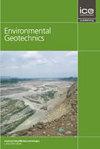利用两种灰盒机器学习模型预测水合石灰活化稻壳灰土的强度性能
IF 2.2
4区 工程技术
Q3 ENGINEERING, GEOLOGICAL
引用次数: 1
摘要
岩土工程在很大程度上依赖于预测土壤强度,以确保安全高效的施工项目。本文以水合石灰活化稻壳灰(HARHA)处理过的土壤为研究对象,对土壤强度特性的准确预测进行了研究。为了实现精确的预测,研究人员采用了两种灰盒机器学习模型——分类与回归树(CART)和遗传规划(GP)。这些模型引入了创新的方程和树,读者可以很容易地应用到新的数据库中。使用由7个输入参数和3个输出变量组成的综合实验室数据库对模型进行训练和测试。结果表明,所提出的CART树和GP方程在所有三个输出变量——加州承载比(CBR)、无侧限抗压强度(UCS)和阻力值(Rvalue)(根据原位锥贯仪测试)上都表现出出色的预测能力。特别是,GP提出的方程在预测UCS和Rvalue参数方面表现出优越的性能,同时在预测CBR方面与CART保持相当的水平。这项研究强调了将灰盒机器学习模型与岩土工程相结合的潜力,为加强未来基础设施开发项目的决策过程和安全措施提供了有价值的见解。本文章由计算机程序翻译,如有差异,请以英文原文为准。
Predicting the Strength Performance of Hydrated-Lime Activated Rice Husk Ash-Treated Soil Using Two Grey-Box Machine Learning Models
Geotechnical engineering relies heavily on predicting soil strength to ensure safe and efficient construction projects. This paper presents a study on the accurate prediction of soil strength properties, focusing on hydrated-lime activated rice husk ash (HARHA) treated soil. To achieve precise predictions, the researchers employed two grey-box machine learning models—classification and regression trees (CART) and genetic programming (GP). These models introduce innovative equations and trees that readers can readily apply to new databases. The models were trained and tested using a comprehensive laboratory database consisting of seven input parameters and three output variables. The results indicate that both the proposed CART trees and GP equations exhibited excellent predictive capabilities across all three output variables—California bearing ratio (CBR), unconfined compressive strength (UCS), and resistance value (Rvalue) (according to the in-situ cone penetrometer test). The GP proposed equations, in particular, demonstrated a superior performance in predicting the UCS and Rvalue parameters, while remaining comparable to CART in predicting the CBR. This research highlights the potential of integrating grey-box machine learning models with geotechnical engineering, providing valuable insights to enhance decision-making processes and safety measures in future infrastructural development projects.
求助全文
通过发布文献求助,成功后即可免费获取论文全文。
去求助
来源期刊

Environmental geotechnics
Environmental Science-Water Science and Technology
CiteScore
6.20
自引率
18.20%
发文量
53
期刊介绍:
In 21st century living, engineers and researchers need to deal with growing problems related to climate change, oil and water storage, handling, storage and disposal of toxic and hazardous wastes, remediation of contaminated sites, sustainable development and energy derived from the ground.
Environmental Geotechnics aims to disseminate knowledge and provides a fresh perspective regarding the basic concepts, theory, techniques and field applicability of innovative testing and analysis methodologies and engineering practices in geoenvironmental engineering.
The journal''s Editor in Chief is a Member of the Committee on Publication Ethics.
All relevant papers are carefully considered, vetted by a distinguished team of international experts and rapidly published. Full research papers, short communications and comprehensive review articles are published under the following broad subject categories:
geochemistry and geohydrology,
soil and rock physics, biological processes in soil, soil-atmosphere interaction,
electrical, electromagnetic and thermal characteristics of porous media,
waste management, utilization of wastes, multiphase science, landslide wasting,
soil and water conservation,
sensor development and applications,
the impact of climatic changes on geoenvironmental, geothermal/ground-source energy, carbon sequestration, oil and gas extraction techniques,
uncertainty, reliability and risk, monitoring and forensic geotechnics.
 求助内容:
求助内容: 应助结果提醒方式:
应助结果提醒方式:


